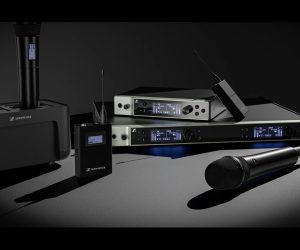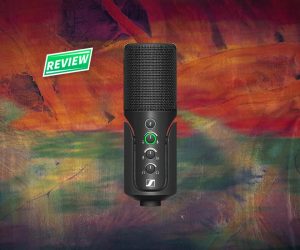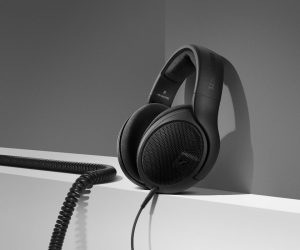
SENNHEISER MK4
Incredibly, this is Sennheiser’s first ever side-address large-diaphragm condenser.
Review: Calum Orr
The new Sennheiser MK4 hits the already teeming large-diaphragm condenser market sector with a modernistic, post-retro bang. It’s sleek, futuristic styling doesn’t take you back to Decca record sleeves of the 1950s or ’60s, but rather propels you 10 years into the future. Indeed, Sennheiser hasn’t bothered to re-manufacture the classic U47 or U67 designs that have sat relatively unmolested in its Neumann stable for years, choosing instead to embrace the future of sound and microphone design with new models that chase other contenders out of the market with their superior value and sonic performance.
LIBERATED DESIGN
The MK4 is very easy on the eye. Not once did I ever catch myself thinking ‘ooh yuck’ while setting the microphone in position for recording, despite its clear departure from ‘classic’ styling that has so many other companies trapped in a ’50s vortex. Reminiscing over past glories is simply not in Sennheiser’s makeup. The MK4 comes across, both visually and aurally, as a microphone that’s been through a fastidious testing regime.
Sennheiser has fairly and squarely aimed the MK4 at the budget-conscious home and project studio market, but I can assure live engineers and professional studios alike that a couple of MK4s on hand would make valuable contributions to anyone’s mic collection. With its one-inch, 24-carat gold-plated diaphragm and a highly effective internal shock mounting system (a matching cradle mount is also available as an option), the MK4 has a low handling noise that’s able to nullify all but the heaviest of floor stomps and boom-stand bumps without the need for calling into duty a separate cradle.
To keep production costs down, the MK4 has a cardioid polar pattern only, and is devoid of pads and high-pass filter switches. The absence of these onboard facilities is becoming the standard amongst budget-conscious microphones the world over, and fair enough too, as you’d be hard pressed to find a decent modern mic pre or mixer that lacks either pads or filters in its preamp section, along with the requisite 48V phantom power needed to bring the mic to life.
UNIVERALLY
To further enhance the sonics of the MK4, Sennheiser has used a single-layer protective mesh design, coupled with a drop collar on the front of the grille, which gives the mic its Star Trek crew-neck appearance. Both of these design elements conspire to make the diaphragm’s housing less reflective and resonant, which, to my ears, works beautifully. The MK4 also has a low-noise (10dB A-weighted), ‘big picture’ (35mm) sound.
I tested this mic against several other players in its class – to borrow a road test cliché – as well as against classic condensers like the solid-state Neumann U47FET and valve AKG C12a. Up against this latter pair the MK4 faired surprisingly well: smoother and airier than the U47FET on voices, though perhaps not as ‘magical’ sounding overall as the superlative C12a valve mic. Modified and unmodified Oktava M-317s, Rode NT-1s and NT-2s meanwhile possessed similarities to the MK4, but none matched its ability to sound good on every source it encountered. In part, this is inevitably due to the fact that Sennheiser’s condenser design is at least 10 years younger than the other mics roped in for comparison – and the MK4’s ability to handle high SPLs (140dB) was particularly impressive – but it’s also the result of Sennheiser’s considerable testing across myriad applications and decades German microphone manufacturing expertise.
DELUXE SOUND
To be more specific, in front of my Fender Blues Deluxe (turned up to un-neighbourly SPLs), the MK4 sounded robust, yet detailed. Being an all-rounder the mic exudes quite a bit of emphasis in the ‘air’ bands (above 8kHz), making it silky smooth on vocals. However, on this particular guitar cabinet I had to administer a substantial dose of low-pass filter action between around 6 and 10kHz to prevent the sound becoming too shiny and glossy. Doing this to some mics can often result in the collapse of the mid-sheen of the instrument, which then requires you to follow up with some judicious EQ to restore the sound back to life. Not so with the MK4: with low-pass filters activated, the representation stayed solid, and when required the MK4 responded nicely to EQ. In all the tests I conducted I felt comfortable boosting and cutting without the tone ever breaking up or falling apart.
I loved the MK4 on acoustic guitar up close, and for that matter at a distance, where it captured a superb impression of my fantastic sounding, 4.5-metre tall hallway – albeit in half-hourly intervals between helicopter take-offs at my local aerodrome! In particular, the test that impressed me most was the MK4’s handling of my ’70s Ibanez 12-string acoustic. This can be a very difficult instrument to record without a multi-mic setup but the MK4 was totally up to the task on its lonesome, capturing the soundboard in a honeyed way, without losing the articulation in the strings or the sweet sound of unison when plucking individual notes. While this particular test was an eye opener on a personal level – it confirmed that Sennheiser is well and truly onto something with the MK4 – I had to resist the temptation to forge my opinion right there on the spot, and go the distance by putting the mic through some rigorous vocal hardship.
POLISHED PROVERBIAL
I say ‘hardship’ because I had to use my voice for the testing! Contrary to what my enemies say, I don’t like the sound of my own voice at all. Nevertheless, the Sennheiser was able to ‘hear’ all of the things I don’t like about my voice with aplomb: a wavering end-note here, a raspy, spluttering chorus there. All uniquely me, but perhaps not surprisingly, a bit more expensive sounding courtesy of the MK4… the ‘polished proverbial’ concept springing quickly to mind here. During the review I even downgraded my mic pre from a Phoenix to an Allen & Heath and still the MK4 refused to sound average.
Wow! For the asking price of $499 I’d buy two of these straight out. I think I’m warming to the new Sennheiser ethos. The age of classic mics hasn’t come and gone, it starts now!

















RESPONSES